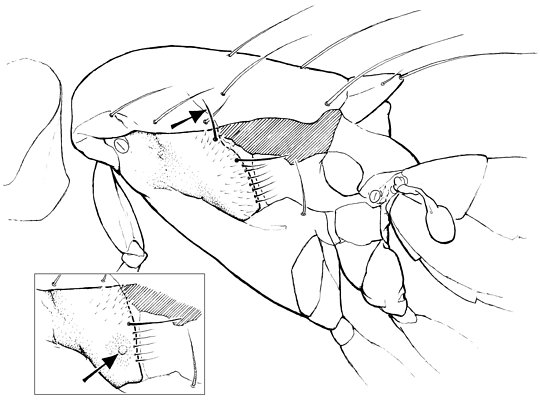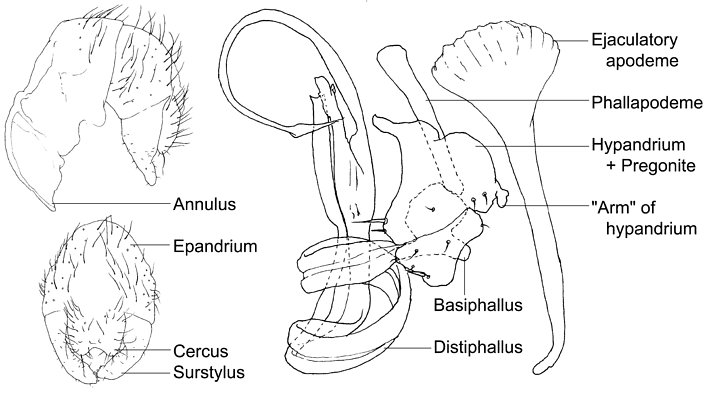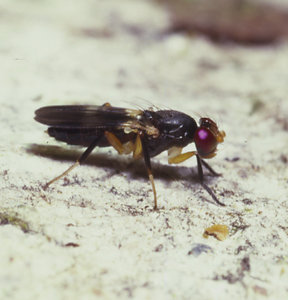Heteromeringia
Owen Lonsdale and Steve MarshallIntroduction
Heteromeringia Czerny is a genus of 62 species that are worldwide in distribution, although only three species are found in the Nearctic (one of which is Neotropical and only reaches Florida) and only H. nigrimana Czerny is found in the Palaearctic (Lonsdale & Marshall, in manuscript). The genus reaches its greatest diversity in the Oriental Region, but numerous species are also found in the Australian, Neotropical and Pacific Regions; a handful of described and undescribed species are known from Fiji, continental Africa, and the Seychelles (Sasakawa 1966, Lonsdale & Marshall unpublished data).
New World Heteromeringia (primarily those collected in the Neotropics) have been found to aggregate around relatively open areas such as tree falls, forest borders, pastures and landslides (Lonsdale & Marshall, in manuscript). McAlpine (1960) also notes that while most Australian clusiids have been taken in rainforests along creeks, species of Heteromeringia have been collected in more open forests. In Europe, Heteromeringia nigrimana is associated with dead wood in deciduous or mixed forests, predominantly on fallen decaying tree trunks (Roh?cek 1995).
Like other clusiids, oviposition following copulation likely occurs in decomposing wood, as Australian specimens of Heteromeringia norrisi McAlpine, 1960 have been bred from rotting wood and one female was collected "in [a] log with termites" (McAlpine 1960).
Specimens of Heteromeringia have been collected using dung bait and dung traps, mushroom traps and carrion (Lonsdale & Marshall, in manuscript).
Characteristics
Heteromeringia is a genus of often darkly pigmented Clusiodinae 2.4-5.0 mm in length. It is often mistaken for Sobarocephala in the New World because it has independently acquired an inclinate anterior fronto-orbital bristle (Lonsdale & Marshall in press). It can be separated from Sobarocephala by having no dorsal preapical tibial bristles, one pair of small lateral scutellar bristles, an elongate double-ribbed phallus that is often strongly coiled and protruding from the abdomen, and fore tarsi that are sometimes elongate and laterally flattened. Heteromeringia also shares the following clusiodine synapomorphies: the antenna arises at or below the midpoint of the head; the outer extension on the pedicel is blunt and obtuse and the inner extension is absent; the scutellum is flat and longitudinally wrinkled dorsally, the hypandrial complex has undergone a large amount of reduction and fusion; the spermathecae are longitudinally segmented and are very often dark and telescoped.
The vast majority of Heteromeringia collected in the Neotropics will belong either to H. czernyi Kertesz or H. fumipennis Melander & Argo. Heteromeringia czernyi differs from H. fumipennis by having an upcurved bristle in the posterodorsal corner of the anepisternum and an additional vibrissa, and H. fumipennis has a wing that is almost entirely darkly infuscated and a small pilose anepisternal disc in the male (Lonsdale & Marshall in manuscript).
 image info
image info
Male thorax lateral: Heteromeringia czernyi Kertesz and H. fumipennis Melander & Argo (inset). ? Owen Lonsdale.
 image info
image info
Heteromeringia nitida Johnson male genitalia; external, left lateral (top); external, posterior (bottom); internal (left lateral, not drawn to scale). ? Owen Lonsdale.
Phylogenetics
Sasakawa (1966) revised the Oriental and Pacific Heteromeringia, where he described 23 new species and erected the genus Tranomeringia, which will likely prove to render Heteromeringia paraphyletic. He provided a key to all Oriental species, genitalic illustrations for all new species, and a phylogeny outlining ten species groups.
Lonsdale & Marshall (in manuscript) are revising the New World Heteromeringia, describing numerous new species and two species groups: the H. czernyi group, which is endemic to the New World and diagnosed by two pairs of vibrissae (in part), and the H. nitida group, which is worldwide in distribution and defined by a pilose disc on the male anepisternum. A world revision will be necessary to resolve the relatively cryptic phylogeny of the genus and its relationship to Tranomeringia.
References
Lonsdale, O & Marshall, S.A. In press. Redefinition of the Clusiinae and Clusiodinae, description of the new subfamily Sobarocephalinae, revision of the genus Chaetoclusia and a description of Procerosoma gen. nov. (Diptera: Clusiidae). European Journal of Entomology.
McAlpine, D.K. 1960. A review of the Australian species of Clusiidae (Diptera: Acalyptrata). Rec. Aust. Mus. 25: 63-94.
Roh?cek, J. 1995. Clusiidae (Diptera) of the Czech and Slovak Republics: Faunistics and notes on biology and behaviour. Cas. Slez. Muz. Opava (A) 44: 123-140.
Sasakawa, M. 1966. Studies on the Oriental and Pacific Clusiidae (Diptera) pt. 1. Genus Heteromeringia Czerny, with one new related genus. Pacific Insects 8(1): 61-100.
Title Illustrations
| Scientific Name | Heteromeringia fumipennis Melander & Argo |
|---|---|
| Specimen Condition | Live Specimen |
| Sex | Female |
| Life Cycle Stage | Adult |
| Copyright | © Steve Marshall |
About This Page
Owen Lonsdale
Insect Systematics Lab
Department of Environmental Biology
University of Guelph
Guelph, ON
N1G 2W1
Canada
Steve Marshall
Insect Systematics Lab
Department of Environmental Biology
University of Guelph
Guelph, ON
N1G 2W1
Canada
Correspondence regarding this page should be directed to Owen Lonsdale at and Steve Marshall at
Page copyright © 2005 Owen Lonsdale and Steve Marshall
- First online 25 August 2005
Citing this page:
Lonsdale, Owen and Marshall, Steve. 2005. Heteromeringia. Version 25 August 2005 (under construction). http://tolweb.org/Heteromeringia/27682/2005.08.25 in The Tree of Life Web Project, http://tolweb.org/








